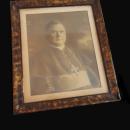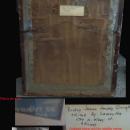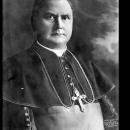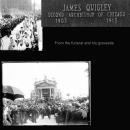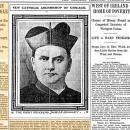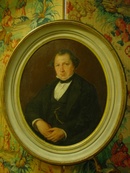1909 Archbishop portrait framed James QUIGLEY With history priest of Diocese of Buffalo Bishop of Chicago
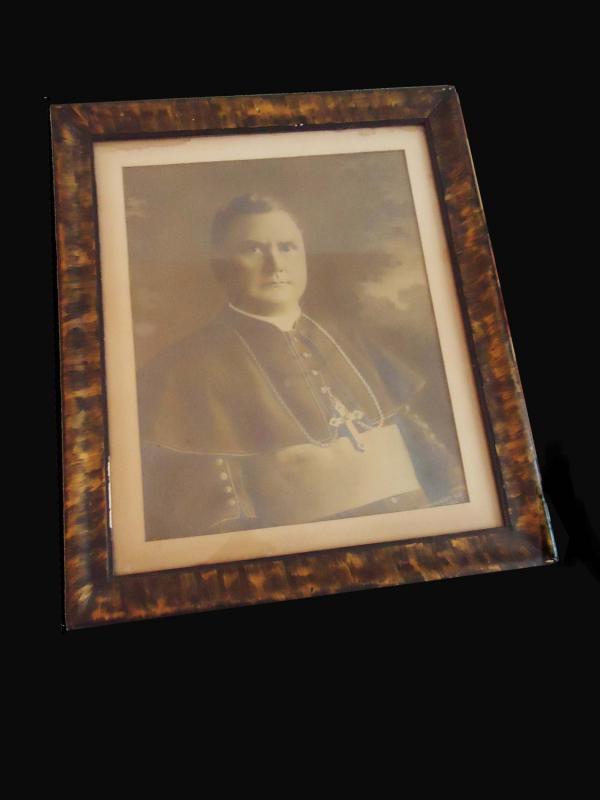
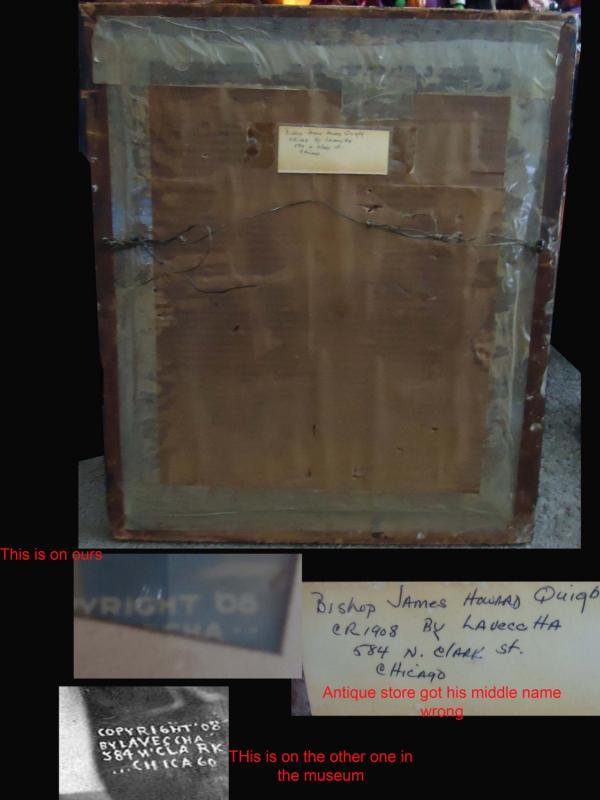
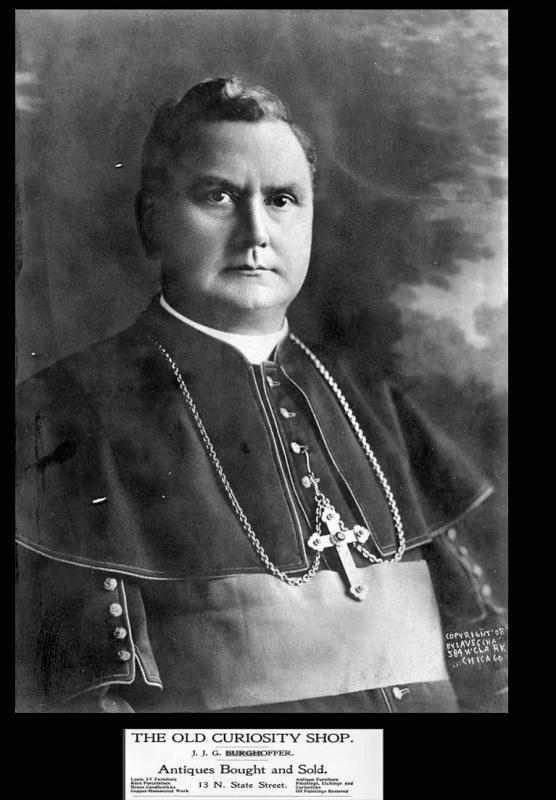
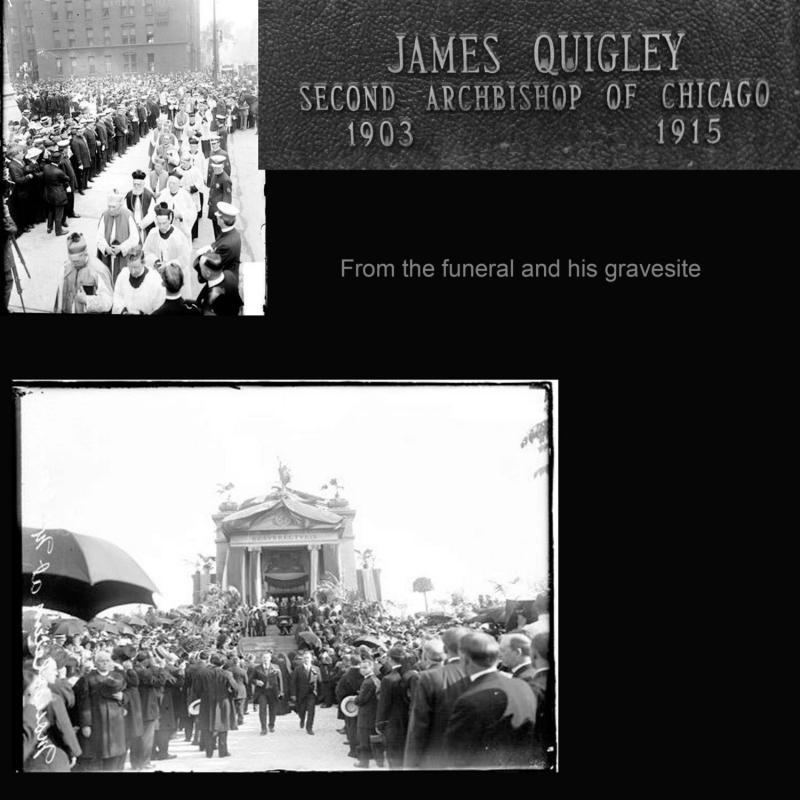

$950.00
This is a glass framed portrait of ARCHBISHOP JAMES QUIGLEY which measures 21 1/2" x 26" . Prior to us it was purchased from an antique store called the Old Curiosity shop on 13 N State street. . The store is no longer in business and the whole block has been torn down and replaced with modern stores. The only other copy of this is in a Catholic museum. It is marked at the bottom copyright 1908 by Lavescha 584 West Clark Chicago. The back of the frame has the original hand written information on it but they got his middle and last name incorrect. It is written James Howard Quigby when it should be James Edward Quigley. We contacted the museum many years ago about this and they did verify they had the other, but did not wish to purchase the second and only other one. I have photos of his funeral, grave site and closeups of the portrait. The closeups are not from ours because there was too much glare so I am showing you the originals. The first photo I have on is the original framed one we are selling. The photo of the back is also of the one we are selling with comparisons on the other one to help identify it. One the full size black and white I have included a copy of the original ad from the store it was originally purchased. Here is his history which is very interesting. Archbishop of Chicago. Born in Oshawa, Ontario, Canada, Oct. 15, 1854. Ordained priest of Diocese of Buffalo, April 12, 1879. Appointed bishop of Buffalo; consecrated Feb. 24, 1897. Appointed archbishop of Chicago, Jan. 8, 1903; installed March 10, 1903. Died July 10, 1915. The second archbishop of Chicago, James Edward Quigley, was a just and charitable man, a thorough and prodigious worker for whom the education of seminarians was a predominating and abiding interest. His 12-year tenure was distinguished by the remarkable growth of both the parochial school and seminary systems. James Edward Quigley was born on October 15, 1854, in Oshawa, Canada, his parents having settled there from Ireland. While still a child, his family moved to Buffalo, N.Y., where he received his education, including some years at the diocesan seminary. He concluded his preparation for the priesthood at the Propaganda College in Rome, where he received his doctorate in theology summa cum laude. He was ordained there in 1879. Following work in St. Vincent Parish in Attica, N.Y., and as rector of St. Joseph Cathedral in Buffalo, he was named Bishop of Buffalo in 1897. Five years later, he became the Archbishop of Chicago. In 1903, Chicago had 252 parishes served by 417 diocesan priests and 149 order priests. With the growing number of Polish, Italian, and Bohemian immigrants, the city was becoming predominantly Catholic. He quickly began adding new parishes spurred on by the tremendous influx of these immigrant groups. His concern in particular for the Polish immigrants caused the number of Polish churches to double. This growth led Archbishop Quigley to seek an auxiliary bishop of Polish decent for Chicago, thus giving the City the distinction of having as an auxiliary bishop the first Pole in the United States to be raised to the episcopacy. While in Rome, Quigley was ordained a priest on April 13, 1879. Following his return to the United States, he served as pastor of St. Vincent's Church in Attica, New York until 1884, when he became rector of St. Joseph's Cathedral in Buffalo. He was transferred to St. Bridget's Church in the same city in 1886 In keeping with Pope Leo XIII's 1891 encyclopedia Rerum novarum, Quigley took an active interest in working conditions. During the dock strike of Buffalo in 1899 the Lake Carriers' Association and the Longshoremen's Union chose him as mediator. After ten days of negotiations, the strike was settled on terms reached by the bishop. It was routine to pay workers in saloons, where often the saloonkeeper was also the hiring boss. This practice was terminated and prohibited by the terms of the agreement With the Archdiocese of Chicago on a solid path of unprecedented growth, Archbishop Quigley turned his attention to the need for a seminary. Clergy personnel needs were critical. Archbishop Quigley understood that the solution to the population expansion and priest shortage lay in the foundation of a seminary system in which Chicago boys could be trained, educated and formed for the priesthood of Chicago. The minor seminary was a popular concept in the early twentieth century, and Archbishop Quigley thought that was a good place to start. The doors to the Cathedral College of the Sacred Heart, as the minor seminary was originally called, were opened in the remodeled German consulate on the southeast corner of Wabash and Superior in October 1905 with 52 high school freshmen. It was Archbishop Quigley who also resurrected the Corporation of the University of St. Mary of the Lake, thus bringing the project of a major seminary to the attention of the Archdiocese. In his opinion the future of the Catholic Church was in the hearts and minds of the children, so one of the distinguishing features of Archbishop Quigley’s administration was the remarkable growth of the parochial school system. In his time as the Ordinary of the Archdiocese the diocesan schools increased from 166 to 256 and the students from 57,329 to 109,162. One of the principles governing the construction of new churches, which he asked pastors to follow, was the provision for a parochial school wherever a church was planned. Archbishop Quigley was interested in all aspects of the social welfare of his people. During his administration the first Catholic social settlements were organized, including nurseries under Catholic direction. For the protection of women, he cooperated with the founding and development of the Catholic Women’s Protectorate, which patrolled railroad stations to offer protection to Catholic girls and women traveling alone. Under his leadership the St. Vincent de Paul Society made remarkable gains in membership and activities in the archdiocese. He helped to establish the Catholic Church Extension Society that served home missions and convened the third diocesan synod in 1905, which promulgated rulings on everything from norms for sermons and the life style of the clergy to the sacraments and worship. The First Catholic Missionary Congress was held in Chicago during this time under the auspices of the Catholic Church Extension Society. He faced great tasks and problems during his tenure, yet never limited his time or energies in his efforts to solve them. He was successful as both a builder of structures and a builder of men, who were shaped and directed in the schools and seminaries of Chicago. His beneficence was noteworthy as illustrated by his custom of performing the funeral rites of every deceased priest of his Archdiocese, a practice he carried out even when he was ill. He died on July 10, 1915, having served as a priest for 36 years and a bishop for 18 years. He was 60 years old at the time of his death. He was buried in the Bishops’ Mausoleum he had ordered the construction of in the Mount Carmel Cemetery, between 1905 and 1912. ( see photo of his grave) Quigley's Chapel of St. James, with stained glass modeled after Sainte-Chapelle in Paris, was dedicated upon the seventy-fifth anniversary of the Archdiocese of Chicago and the twenty-fifth anniversary of Mundelein's priestly ordination on 10 June 1920. Designed by architect Zachary Taylor Davis,[7] with stained glass by Robert Giles of the John J. Kinsella Company of Chicago, it has been listed on the National Register of Historic Places since 1996. The American Institute of Architects Guide to Chicago has termed the stained glass of the Quigley Chapel "dazzling." This framed portrait has a thin line of watermarks at the top but the photo or print is totally intact. You are getting the frame, glass and portrait inside. Sold as found.
